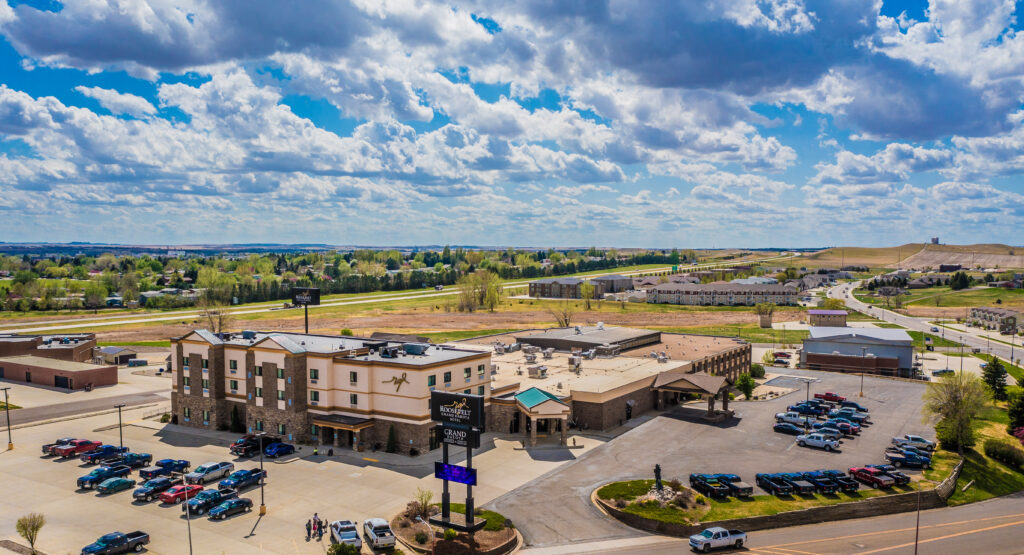Industrial Growth in North Dakota
North Dakota’s industrial portfolio is diverse and steadily growing. A few key industries dominate the landscape.
Energy
The state is a major player in the U.S. energy sector, especially with its vast reserves of oil and natural gas. The Bakken shale formation, primarily located in western North Dakota, has been a focal point for oil extraction, making the state one of the top oil producers in the country. This has spurred the growth of various support industries, from drilling equipment manufacturers to logistics and transportation services catering to the energy sector.
Agriculture
Agriculture remains a cornerstone of North Dakota’s economy. The state is a leading producer of crops like wheat, soybeans, and sunflower seeds. This has given rise to numerous agri-based industries, including processing plants, machinery manufacturing, and biofuel production.
Technology
While not as historically entrenched as energy or agriculture, the tech sector in North Dakota is expanding. Initiatives like the Grand Farm project aim to merge the state’s agricultural prowess with cutting-edge technology, leading to advancements in areas like precision farming.
Manufacturing
Over the years, North Dakota’s manufacturing sector has seen considerable growth, driven by its proximity to raw materials and a strategic central location for distribution. From aerospace components to specialized machinery tailored for the state’s primary industries, manufacturing entities have harnessed local expertise and resources to carve a perfect place in both domestic and international markets.
How has Industrial Growth Evolved?
The tale of industrial growth in North Dakota is both fascinating and emblematic of the broader shifts in the American economy. Historically, the state’s economy was heavily tilted towards agriculture. Vast expanses of fertile land made it ideal for large-scale farming. By the mid-20th century, however, the discovery and subsequent extraction of oil, especially in the Williston Basin, changed the state’s industrial trajectory.
The oil boom, particularly in the 21st century with the advancements in hydraulic fracturing and horizontal drilling, led to a massive influx of investment and labor into the state. Towns that were previously quiet saw rapid expansion, and the state’s GDP grew substantially.
Yet, the cyclical nature of the oil industry, coupled with global market fluctuations, meant that relying solely on energy was risky. Recognizing this, the state government and private enterprises have made concerted efforts to diversify the industrial base. Investment in technology, especially tech that complements existing strongholds like agriculture, has been a recent trend. Simultaneously, efforts have been made to boost manufacturing, tourism, and other sectors to create a balanced, resilient economy.
Today, while energy and agriculture remain dominant forces, North Dakota’s industrial landscape is more varied and robust, ensuring it’s better equipped to handle future challenges and market shifts.

Benefits of Investing in Industrial Lots
Industrial lots, expanses of land zoned specifically for industrial activities, have always been of interest to forward-thinking investors. These lots are beneficial for numerous reasons. Investing in industrial lots not only promises potential capital appreciation but also paves a path for business operations, given the right industry and market conditions.
North Dakota, often heralded for its rich natural resources and agricultural prowess, is now stepping into the limelight for its industrial lots. As the state undergoes dynamic economic transformations, industrial real estate emerges as a gold mine for savvy investors. But what makes these lots in the Peace Garden State particularly alluring? From strategic positioning to a supportive business ecosystem, investing in North Dakota’s industrial lots presents many benefits, ripe for exploration. Join us as we delve into the compelling advantages of this burgeoning investment frontier.
Cost Advantages Compared to Urban Areas or Other States
Investing in industrial lots in less densely populated areas, like parts of North Dakota, often presents significant cost benefits. Urban areas typically have higher land prices due to demand pressures and limited availability. In contrast, North Dakota, especially in its southwestern region, offers competitively priced lots that allow businesses to have larger operational spaces without the exorbitant costs. Additionally, operational expenses, such as utilities and local taxes, tend to be lower than in larger urban centers or states with a higher cost of living.
Infrastructure and Connectivity
Good infrastructure is crucial for industrial growth, and North Dakota doesn’t disappoint. With a network of well-maintained highways, rail connections, and airports, the state ensures efficient movement of goods both internally and to external markets. The state’s central location in North America is a logistical advantage, positioning businesses closer to the East and West Coasts. This means reduced transportation time and costs, making product distribution more efficient. Moreover, the state has continually invested in improving its infrastructure, ensuring it meets the evolving demands of industries.
Local Incentives and Policies Supporting Industrial Growth
North Dakota has a proactive approach to fostering industrial growth. Recognizing the importance of diversification and sustainable economic expansion, local governments and state agencies have rolled out plenty of incentives. These may include tax breaks, grants for research and development, training programs to upskill local workers, and reduced bureaucracy for faster business setups. The state’s favorable regulatory environment also aids businesses in navigating the initial stages of setting up and expansion, reducing red tape and potential roadblocks.
Potential ROI Based on Previous and Projected Growth Trends
Historical data and growth trajectories paint an optimistic picture for investors eyeing North Dakota. The state’s boom in the energy sector, especially with the Bakken shale oil play, has demonstrated the potential for massive ROI in the right industries. While the energy sector’s cyclical nature does present risks, the state’s diversification push, particularly in sectors like technology, agriculture, and manufacturing, offers multiple avenues for investment.
Furthermore, as industries grow and the state becomes an increasingly attractive business hub, there’s potential for land appreciation. Early investment in industrial lots could yield significant returns as demand increases. Drawing parallels with previous growth spurts, and considering the state’s proactive approach to business support, the potential for a strong ROI for forward-thinking investors is evident.
SW North Dakota: Why Here?
Southwestern North Dakota has gained prominence for its flourishing industrial potential. As businesses scan the horizon for strategic investment opportunities, SW North Dakota beckons with its unique blend of geographical strengths, a committed workforce, and competitive pricing.
Geographical Advantages
Southwestern North Dakota is strategically positioned, offering a unique blend of accessibility and resource richness. Its proximity to the Bakken shale formation makes it a hotspot for the energy sector, especially oil and natural gas extraction. This resource wealth doesn’t just end at energy; the fertile plains in and around this region are vital for agriculture, supporting a variety of crops and livestock.
Moreover, SW North Dakota’s central location within the U.S. means it’s well-connected to other industrial hubs, both in the Midwest and the broader Western region. This connectivity ensures efficient transportation of goods and facilitates collaboration with other industrial centers, making business operations smoother and more integrated.
Local Workforce and Talent Pool
The boom in the energy sector and the state’s push for industrial growth have led to a migration of skilled laborers and professionals to North Dakota, with a notable concentration in the southwestern region. Educational institutions in and around the area, recognizing the evolving industrial landscape, have tailored programs to cater to these sectors, ensuring a steady flow of trained professionals ready to join the workforce.
Moreover, North Dakota’s strong community values and work ethic translate into a reliable, diligent, and skilled workforce. Businesses setting up in the region can tap into this talent pool, reducing the time and costs associated with hiring and training.
Competitive Land Prices
One of the standout features attracting businesses to SW North Dakota is its competitive land pricing. Compared to bustling urban centers or coastal areas, the cost of acquiring industrial lots here is considerably lower. This cost advantage allows businesses to allocate resources more efficiently, investing in infrastructure, technology, and workforce development, thereby enhancing their operational capacity and competitiveness.

Success Stories of Businesses That Invested Here
Numerous businesses have recognized SW North Dakota’s potential and have reaped significant rewards from their investment.
Energy Giants
Companies like Hess Corporation and Continental Resources have heavily invested in the region, especially capitalizing on the Bakken shale oil play. Their success stories underscore the region’s potential in the energy sector, with both companies seeing impressive growth rates and returns on investment.
Agricultural Endeavors
With the region’s fertile lands, many agri-based businesses have found success. North Dakota Mill and Elevator, for instance, has benefited from the agricultural richness of the region, effectively connecting local farmers to wider markets.
Manufacturing Innovations
Southwestern North Dakota is not only a hub for traditional industries but has also witnessed a surge in manufacturing innovations. Companies in Dickinson, such as Steffes and TMI, stand testament to this. Steffes, with its diverse product range from oilfield solutions to custom manufacturing, and TMI, known for its specialized HVAC solutions, showcase the region’s adaptability and prowess in advanced manufacturing. Their success stories in SW North Dakota underline how merging traditional methods with modern manufacturing techniques, set against the backdrop of the region’s unique advantages, can pave the way for profitable ventures.
Risks and Challenges
Every promising investment opportunity comes with its share of potential risks and challenges, and SW North Dakota’s industrial lots are no exception. While the region boasts a myriad of benefits, from its rich resources to its strategic location, investors must also be prepared to navigate the complexities and uncertainties inherent to any investment landscape.
Economic Fluctuations
Like any region, North Dakota is not immune to economic fluctuations that could influence the value and potential returns on industrial investments. The state’s economy, primarily tied to the energy sector, especially oil, is susceptible to global oil price fluctuations. A decline can slow drilling activities and reduce job opportunities, potentially affecting the overall economic health of the region. However, such downturns also bring opportunities for innovation, diversification, and market resilience. Furthermore, the cyclical nature of the oil industry means there are also periods of strong growth and profitability, allowing investors to capitalize on upswings.
Potential Oversaturation of Industries
The allure of SW North Dakota’s benefits can entice numerous investors and businesses to the region. There’s a risk of industries becoming oversaturated, potentially impacting long-term viability. But, on the bright side, such competition can also foster innovation, drive efficiencies, and raise the standard of products and services offered. Moreover, diversification is key: as certain sectors may become saturated, others remain ripe for development, presenting fresh opportunities for discerning investors.
External Factors
Global economic downturns and other external factors can significantly shape SW North Dakota’s investment landscape. These externalities, ranging from reduced global demand to geopolitical tensions, can influence the region’s economic output. Moreover, policy changes, at both federal and state levels, can redefine the business climate. Yet, North Dakota’s resilient spirit and tradition of adaptability mean the state is often quick to recalibrate and find new pathways to growth. External challenges often lead to internal strengthening, as businesses evolve to become more competitive, adaptive, and innovative in the face of changing circumstances.

SW North Dakota stands as a beacon of potential in the realm of industrial investment. With its rich resources, strategic geographical positioning, and vibrant local workforce, the region presents a compelling argument for those seeking lucrative opportunities. Yet, as with any investment, it’s crucial to approach with both eyes open, understanding both the vast potential and the inherent challenges.
For those keen on navigating this landscape, conducting thorough research is paramount. Should you wish to delve deeper into the specifics or seek guidance on the intricacies of SW North Dakota’s industrial sector, we encourage you to reach out to agents and specialists. Their expertise can provide invaluable insights, ensuring that your investment journey in the region is both informed and successful.



